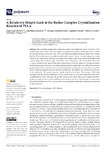A relatively simple look at the rather complex crystallization kinetics of PLLA

Use este enlace para citar
http://hdl.handle.net/2183/33079
Excepto si se señala otra cosa, la licencia del ítem se describe como Creative Commons Attribution (CC BY) license https://creativecommons.org/licenses/by/4.0/
Colecciones
- Investigación (EPEF) [590]
Metadatos
Mostrar el registro completo del ítemTítulo
A relatively simple look at the rather complex crystallization kinetics of PLLAAutor(es)
Fecha
2023-04-14Resumen
[Abstract] This work demonstrates that, despite the existence of a significant number of works on PLA crystallization, there is still a relatively simple way, different from those already described, in which its complex kinetics can be observed. The X-ray diffraction (XRD) results presented here confirm that the PLLA under study crystallizes mostly in the α and α′ forms. An interesting observation is that at any temperature in the studied range of the patterns, the X-ray reflections stabilize with a given shape and at a given angle, different for each temperature. That means that both α and α′ forms coexist and are stable at the same temperatures so that the shape of each pattern results from both structures. However, the patterns obtained at each temperature are different because the predominance of one crystal form over the other depends on temperature. Thus, a two-component kinetic model is proposed to account for both crystal forms. The method involves the deconvolution of the exothermic DSC peaks using two logistic derivative functions. The existence of the rigid amorphous fraction (RAF) in addition to the two crystal forms increases the complexity of the whole crystallization process. However, the results presented here show that a two-component kinetic model can reproduce the overall crystallization process fairly well over a broad range of temperatures. The method used here for PLLA may be useful for describing the isothermal crystallization processes of other polymers.
Palabras clave
PLA
Crystallization
DSC
Kinetics
Crystallization
DSC
Kinetics
Versión del editor
Derechos
Creative Commons Attribution (CC BY) license https://creativecommons.org/licenses/by/4.0/
ISSN
2073-4360






